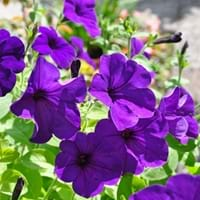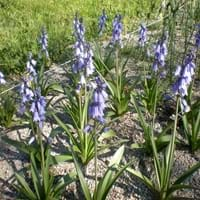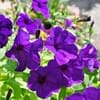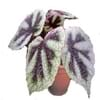Life Span
Annual
Perennial
Type
Flowering Plants, Shrubs
Bulb or Corm or Tuber
Origin
Hybrid origin
Southern Europe, Western Europe, Northern Africa
Types
19
Hyacinthoides flahaultiana, Hyacinthoides mauritanica, Hyacinthoides reverchonii
Number of Varieties
Not Available
Habitat
Terrestrial
Parks, wastelands, Waysides, Woodland edges
USDA Hardiness Zone
9-10
4-10
Sunset Zone
A1, A2, A3, H1, H2, 1a, 1b, 2a, 2b, 3a, 3b, 4, 5, 6, 7, 8, 9, 10, 11, 12, 13, 14, 15, 16, 17, 18, 19, 20, 21, 22, 23, 24
21,22
Habit
Prostrate/Trailing
Clump-Forming
Flower Color
White, Blue, Purple, Pink, Light Pink, Hot Pink, Magenta, Lavender
White, Blue, Pink, Blue Violet
Flower Color Modifier
Bicolor
Bicolor
Fruit Color
Not Available
Not Available
Leaf Color in Spring
Green
Green
Leaf Color in Summer
Green
Light Green
Leaf Color in Fall
Green
Several shades of Green
Leaf Color in Winter
Light Green
Light Green
Plant Season
Spring, Summer, Fall
Spring
Sunlight
Full Sun
Partial Sun, Partial shade
Growth Rate
Very Fast
Medium
Type of Soil
Loam, Sand
Loam
The pH of Soil
Acidic, Neutral
Acidic, Neutral
Soil Drainage
Well drained
Well drained
Bloom Time
Indeterminate
Spring, Late Spring
Tolerances
Drought
Drought
Where to Plant?
Container, Ground, Pot
Ground
How to Plant?
Seedlings, Transplanting
By dividing rhizomes, tubers, From bulbs, Seedlings
Plant Maintenance
Medium
Medium
Watering Requirements
Keep the ground moist but not water-logged, Requires regular watering, Requires watering in the growing season
Average Water Needs, Do Not over Water, Requires regular watering
In Summer
Lots of watering
Lots of watering
In Spring
Moderate
Moderate
In Winter
Average Water
Average Water
Soil pH
Neutral
Acidic, Neutral
Soil Type
Loamy, Sandy
Loam
Soil Drainage Capacity
Well drained
Well drained
Sun Exposure
Full Sun, Partial shade
Partial Sun, Partial shade
Pruning
Cut or pinch the stems, Do not prune during shooting season, Remove dead or diseased plant parts, Remove deadheads
Pinch Tips, Remove damaged leaves, Remove dead branches, Remove dead leaves, Remove dead or diseased plant parts
Fertilizers
All-Purpose Liquid Fertilizer
High amounts of nutrients, organic fertlizers
Pests and Diseases
Red blotch
Red blotch
Plant Tolerance
Drought
Drought
Flower Petal Number
Single
Single
Foliage Texture
Medium
Medium
Foliage Sheen
Matte
Glossy
Attracts
Hummingbirds, Butterflies
Birds, Butterflies, pollinators
Allergy
Not Available
Pollen
Aesthetic Uses
Beautification, Bouquets, Showy Purposes
Showy Purposes
Beauty Benefits
Not Available
Not Available
Environmental Uses
Air purification
Air purification
Medicinal Uses
Not Available
Not Available
Part of Plant Used
Flowers
Flowers
Other Uses
Showy Purposes
Beneficial species for attracting pollinators, Decoration Purposes, Showy Purposes, Used for Landscaping
Used As Indoor Plant
Yes
No
Used As Outdoor Plant
Yes
Yes
Garden Design
Hanging Basket
Container, Cutflower, Mixed Border, Rock Garden / Wall, Wildflower
Botanical Name
PETUNIA 'PAS3187'
HYACINTHOIDES hispanica
Common Name
Purple Wave Petunia, Spreading Petunia, Wave Purple Petunia
Spanish Bluebell
In Hindi
Purple wave petunia
Bluebell plant
In German
Lila Welle Petunie
Endymion Pflanze
In French
Pétunia pourpre Vague
plante Bluebell
In Spanish
Petunia púrpura Wave
planta Bluebell
In Greek
Purple Wave πετούνια
φυτό Bluebell
In Portuguese
Onda roxa do petúnia
planta Bluebell
In Polish
Purpurowy fali petunii
Bluebell roślin
In Latin
Purpura unda Petunia
Bluebell herba
Phylum
Magnoliophyta
Magnoliophyta
Class
Magnoliopsida
Liliopsida
Family
Solanaceae
Liliaceae
Genus
Petunia
Hyacinthoides
Clade
Angiosperms, Asterids, Eudicots
Angiosperms, Monocots
Tribe
Not Available
Hyacintheae
Subfamily
Petunioideae
Scilloideae
Importance of Purple Wave Petunia and Bluebell
Want to have the most appropriate plant for your garden? You might want to know the importance of Purple Wave Petunia and Bluebell. Basically, these two plants vary in many aspects. Compare Purple Wave Petunia and Bluebell as they differ in many characteristics such as their life, care, benefits, facts, etc. Every gardener must at least have the slightest clue about the plants he wants to plant in his garden. Compare their benefits, which differ in many ways like facts and uses. The medicinal use of Purple Wave Petunia is Not Available whereas of Bluebell is Not Available. Purple Wave Petunia has beauty benefits as follows: Not Available while Bluebell has beauty benefits as follows: Not Available.
Compare Facts of Purple Wave Petunia vs Bluebell
How to choose the best garden plant for your garden depending upon its facts? Here garden plant comparison will help you to solve this query. Compare the facts of Purple Wave Petunia vs Bluebell and know which one to choose. As garden plants have benefits and other uses, allergy is also a major drawback of plants for some people. Allergic reactions of Purple Wave Petunia are Not Available whereas of Bluebell have Pollen respectively. Having a fruit bearing plant in your garden can be a plus point of your garden. Purple Wave Petunia has no showy fruits and Bluebell has no showy fruits. Also Purple Wave Petunia is not flowering and Bluebell is flowering. You can compare Purple Wave Petunia and Bluebell facts and facts of other plants too.





